David Composing the Psalms From the Paris Psalter Art Description
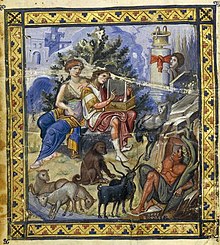
The Paris Psalter (Paris, Bibliothèque Nationale, MS. gr. 139) is a Byzantine illuminated manuscript, 38 x 26.v cm in size, containing 449 folios and xiv full-folio miniatures. The Paris Psalter is considered a central monument of the so-called Macedonian Renaissance, a 10th-century renewal of involvement in classical art closely identified with the emperor Constantine Vii Porphyrogenitus (909-959) and his immediate successors.
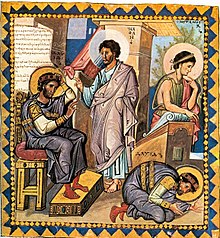
Reproach of Nathan, c. 950, fol. 136v.
In the nomenclature of Greek biblical manuscripts, it is designated by siglum 1133 (Rahlfs).
Description [edit]
The Paris Psalter is a re-create of the 150 Psalms of David, translated from Hebrew into demotic Greek. The psalter is followed past the Canticles of the Quondam Testament, a further series of prayers. Both these texts were particularly well-suited for employ by members of the laity in individual devotional exercises. The popularity of this use of the psalter is reflected in the numerous extant luxury copies, oft lavishly illuminated, made for royal and aristocratic patrons.[1] The Paris Psalter is the pre-eminent Byzantine example of this genre.
The Paris Psalter includes non merely the biblical texts, but an extensive interpretive gloss of the entire cycle of prayers. This commentary, which comprises quotations and paraphrases of patristic exegetical works, surrounds the verses. Fifty-fifty though it is written in a smaller pitch than the master text, the gloss occupies far more than of each page than the psalms, which are reduced to a few verses per page. The length of the gloss causes the longer psalms to occupy upward to 8 pages.
Glossed biblical texts were usually commissioned by monastic libraries, clerics and theologians. The classical and royal iconography and sumptuousness of the Paris Psalter, withal, strongly point to an imperial patron; while the gloss implies a reader with serious intellectual and spiritual inclinations, such as Constantine 7.
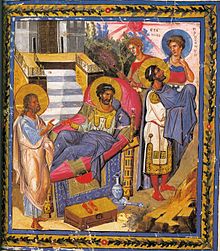
Healing of Hezekiah, fol. 466v.
The manuscript is written in a minusucule bouletée manus, which closely resembles that of several other Byzantine manuscripts of the aforementioned period, including an illuminated gospel volume, (Parisinus graecus 70); a Gospel Book (London, British Library Add MS eleven 300); a Gospel Book (Venice, Biblioteca Marciana Marcianus graecus I eighteen); the Acts and Epistles (Oxford, Bodleian Library MS. Catechism. Gr. 110); and Basil of Caesarea (Oxford, Corpus Christi 26). These books, along with the Paris Psalter, were, in all likelihood, produced in the same Constantinopolitan scriptorium.
The manuscript'south importance in art history is based on the 14 superb, full-page illuminations that illustrate its texts. These singleton pages were tipped in to the manuscript and are not role of its regular gathering construction. The first seven images preceding the text depict scenes from the life of David, the author of the psalms, who is ordinarily accompanied by personifications. The eighth miniature marks the get-go of the penitential Psalms; and the concluding six, depicting Moses, Jonah, Hannah, Ezekiel and Hezekiah, introduce and illustrate the Canticles of the Old Attestation. The subject of the miniatures is as follows:
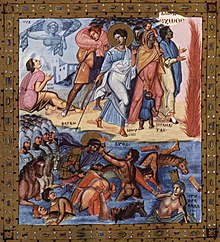
Moses Departing the Red Sea, fol.419v.
1v: David playing the harp with Melodia (μελωδία) seated beside him;
2v: David kills the lion assisted by Strength (ἰσχύς);
3v: The anointing of David past Samuel, with Lenity (πραότης) observing;
4v: David, accompanied past Power (δύναμις) slays Goliath, equally Arrogance (ἀλαζόνεια) flees;
5v: Triumphant Return of David to Jerusalem;
6v: Coronation of David past Saul;
7v: David Stands with a psalter open to Psalm 71, flanked past Wisdom (σοφία) and Prophecy (προφητεία);
136v: Nathan Rebukes David concerning Bathsheba; the Penitence of David with Repentance (μετάνοια);
419v: Moses parting the Ruby Bounding main, with personifications of the desert, night, the abyss, and the Ruby Sea;
422v: Moses Receives the Tablets of the Law;
428v: Hannah thanks God for the birth of Samuel;
431v: Scenes from Jonah;
435v: Isaiah with Night (νύξ) and Dawn (ὄρθρος);
446v: King Hezekiah.
Jean Porcher has assigned the total-page illuminations to five artists, or easily, attributing 6 miniatures to the pb creative person, Hand A.[2]
History [edit]
The full-blown classicism of the painting style and iconographic parallels with Roman wall painting led 19th-century scholars to engagement the manuscript to the early sixth century. In the early 20th century, however, Hugo Buchthal and Kurt Weitzmann, took issue with the Late Antique dating, conclusively demonstrating that the fully realized, confident classicism and illusionism of the miniatures were the product of the 10th century, thereby extending the persistence of classical art in Byzantium well into the Middle Ages.
The majority of the full-page illuminations draw key scenes from the life of Male monarch David. The iconography of the miniatures alludes to David's authorship of the psalms, but scenes like Samuel anointing David and the Coronation of David by Saul emphasize the former'southward status as a divinely-appointed ruler. The emphasis on biblical kingship and the studied classicism of the miniatures has led scholars to propose the scholar emperor Constantine VII Porphyrogenitus (905 - 959) as the patron and/or owner of the manuscript, which would locate its production in the purple scriptorium. Known not only for his involvement in classical texts, but for his artistic abilities too, Constantine VII may have direct supervised the squad of artists.[3] Whether the psalter was intended for Constantine VII'due south personal utilize, or ordered every bit a gift for his son, Romanos Two at the time of his elevation to the status of co-emperor in 945, its text and images of David would have been interpreted as biblical examples of kingship on which the Christian emperor might model his own rule and moral conduct.
Although the astonishing classicism and emphasis on kingship strongly suggest the majestic patronage of Constantine 7, the primeval documentation of the manuscript takes the form of copies of several of the miniatures that appear in several 13th-century manuscripts.[4] These copies suggest that the manuscript was in the majestic library after the expulsion of the Latin usurpers, and continued to be highly regarded in the Paleologan period.
The provenance proper begins in 1558, when Jean Hurault de Boistaillé, the French ambassador to Constantinople, acquired the book from the Sultan Suleiman I. The acquisition of the book and its price are recorded in an inscription on fol. 1r: Ex bibliotheca Jo. Huralti Boistallerii. Habui ex Constantinopoli pretio coronatorum 100. The library of the Hurault family unit was caused for the Bibliothèque du Roi in 1622, which became the core collection of the Bibliothèque Nationale de French republic.
Illustrations [edit]
(Excluding those illustrated higher up)
- Paris Psalter, full-page illuminations
-

Paris Psalter, Hannah'southward Prayer, c. 950, Paris, Bibliothèque Nationale de France ms. grec 139, fol. 428v.
-
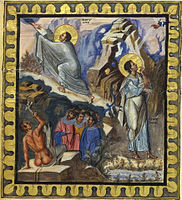
Paris Psalter, Moses Receiving the Tablets of the Law, c. 950, Paris, Bibliothèque Nationale de France ms. grec 139, fol. 422v.
-

Paris Psalter, David Glorified by the Women of State of israel, c. 950, Paris, Bibliothèque Nationale de France ms. grec 139, fol. 5v.
-

Paris Psalter, Isaiah's Prayer, c. 950, Paris, Bibliothèque Nationale de France ms. grec 139, fol. 435v.
-

Paris Psalter, David Holding Open Psalter with Wisdom and Prophecy, c. 950, Paris, Bibliothèque Nationale de French republic ms. grec 139, fol. 7v.
-

Paris Psalter, David fighting the lion with Forcefulness, c. 950, Paris, Bibliothèque Nationale de France ms. grec 139, fol. 2v.
-

Paris Psalter, Scenes from Jonah, c. 950, Paris, Bibliothèque Nationale de French republic ms. grec 139, fol. 431v.
-

Paris Psalter, David Crowned past Saul, c. 950, Paris, Bibliothèque Nationale de France ms. grec 139, fol. 6v.
-

Paris Psalter, David anointed by Samuel, c. 950, Paris, Bibliothèque Nationale de French republic ms. grec 139, fol. 3v.
David and Goliath miniature, fol. 4v [edit]
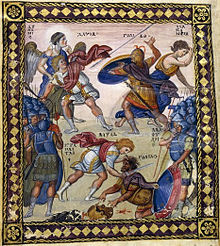
David and Goliath, fol. 4v.
The David and Goliath miniature, fol. 4v, depicts the concluding battle between the young David and Goliath, with David defeating Goliath.[5] The painting also represents an encomium, or the praise of a person or thing, in relation to the rulers of Macedonia.[half-dozen] The spiritual context, notwithstanding, builds on the concept of imperial organization beingness sanctioned past God. The painting can also be viewed as an allusion to Christ'due south triumph over Satan (spiritual) or the victory of a ruler over an adversary (secular).
[7] The Paris Psalter is very famous inside ancient Byzantine fine art, and although at that place are other psalters, this is the about famous out of the 70 five illuminated Byzantine psalters. A common theme in the Paris Psalter is the portrayal of platonic rulers, this portrayal is meant to signify their importance in their era and to glorify them.[6]
The story of David and Goliath begins in the valley of Elah, where the Philistine regular army and Saul'south army met in battle. Goliath was a Philistine giant who repeated appeared on a hill to claiming the Saul army, a challenge to which none of Saul's army accepted. David's three older brothers were members of Saul'southward regular army, while due to David'south young age he stayed at abode. Whilst delivering supplies to his brothers on the battlefield, David's pride made him determined to defeat this giant for the sake of his people. With the permission of King Saul, David set out on his mission to defeat Goliath, and the conflicts between them began.[8] Although the identity of the creative person of the Paris Psalter and David and Goliath inside it remains unknown, this history of conflict between David and Goliath was the inspiration for the delineation of David's victory over Goliath.
Notes [edit]
- ^ Kurt Weitzmann, "The Ode Pictures of the Aristocratic Psalter Recension," Dumbarton Oaks Papers 30 (1976): 67–84, here p. 73; and idem, "The Psalter Vatopedi 761: Its Place in the Aristocratic Psalter Recension," Journal of the Walters Art Gallery ten (1947): 21–51, here p. 47.
- ^ Porcher, Jean (1958). Byzance et la France Médiévale: Manuscrits à Peintures du 11e au XVIe Siècle. Paris: Bibliothèque Nationale. ISBN9782717700374.
- ^ Beckwith, John (1970). Early on Christian and Byzantine Art. Pelican History of Fine art. Harmondsworth: Penguin. pp. 201–207.
- ^ Encounter, for instance, the miniature of David and Nathan in the tardily 13th-century psalter at present in the Greek Patriarchate Library in Jerusalem.
- ^ Wander, Steven H. (1973). "The Republic of cyprus Plates: The Story of David and Goliath". Metropolitan Museum Periodical. viii: 89–104. doi:10.2307/1512675. JSTOR 1512675.
- ^ a b "The Byzantine Legacy".
- ^ "The Paris Psalter".
- ^ "David and Goliath". www.chabad.org . Retrieved 2019-04-03 .
References [edit]
- Wander, Due south. (2014). The Paris Psalter (Paris, Bibliothèque nationale, cod. gr. 139) and the Antiquitates Judaicae of Flavius Josephus. Word & Image, thirty(2), 90-103.
- Anderson, J. (1998). Farther Prolegomena to a Study of the Pantokrator Psalter: An Unpublished Miniature, Some Restored Losses, and Observations on the Human relationship with the Chludov Psalter and Paris Fragment. Dumbarton Oaks Papers, 52, 305-321.
- H. Buchthal. (1938). The Miniatures of the Paris Psalter : A Report in Middle Byzantine Painting, Studies of the Warburg Institute, Vol. ii (London: Warburg Institute, 1968).
- Maxwell, Kathleen. (1987). "The Aristocratic Psalters in Byzantium," Speculum: A Journal of Medieval Studies, 62, 406.
- Lowden, J. (1988). "Observations on Illustrated Byzantine Psalters." The Art Bulletin, 70(2), 242-260.
External links [edit]
- Paris Psalter (Paris, Bibliothèque Nationale, MS. gr. 139) - Complete high resolution scan of the manuscript on Gallica.
Source: https://en.wikipedia.org/wiki/Paris_Psalter
0 Response to "David Composing the Psalms From the Paris Psalter Art Description"
Postar um comentário